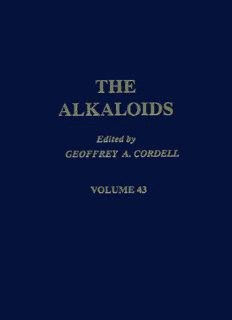
The Alkaloids: Chemistry and Pharmacology 43 PDF
Preview The Alkaloids: Chemistry and Pharmacology 43
THE ALKALOIDS Chemistry and Pharmacology VOLUME 43 This Page Intentionally Left Blank THE ALKALOIDS Chemistry and Pharmacology Edited by Geoffrey A. Cordell College of Pharmacy University of Illinois at Chicago Chicago, Illinois VOLUME 43 Academic Press, Inc. Harcourt Brace Jovanovich, Publishers San Diego New York Boston London Sydney Tokyo Toronto This book is printed on acid-free paper. @ Copyright 0 1993 by ACADEMIC PRESS, INC. All Rights Reserved. No part of this publication may be reproduced or transmitted in any form or by any means, electronic or mechanical, including photocopy, recording, or any information storage and retrieval system, without permission in writing from the publisher. Academic Press, Inc. 1250 Sixth Avenue, San Diego, California92101-4311 United Kingdom Edition published by ACADEMIC PRESS LIMITED 24-28 Oval Road, London NWI 7DX Library of Congress Catalog Number: 50-5522 International Standard Book Number: 0- 12-469543-4 PRINTED IN TIE UNITED STA'IES OF AMERICA 9394959691 QW 9 8 7 6 5 4 3 2 1 CONTENTS CONTRIBUTORS.. ....................................................... vii PREFACE ............................................................... ix Chapter 1 . Allelochemical Properties or the Raison d'Etre of Alkaloids MICHAELW INK I . Introduction ...................................................... I I1 . Allelochemical Properties of Alkaloids ............................... 5 111 . Raison d'Etre of Alkaloids ......................................... 86 IV . Conclusions ...................................................... I03 References ....................................................... 104 Chapter 2 . Mammalian Alkaloids I1 ARNOLDB ROSSI 1. Introduction ...................................................... I1 . Mammalian Indole Alkaloids ....................................... 111 . Mammalian Isoquinoline Alkaloids .................................. IV . Mammalian Morphine ............................................. V . Alkaloid Formation in Mammals as a Therapeutic Concept ............. VI . Addendum ....................................................... VII . Conclusions ...................................................... References ....................................................... Chapter 3 . Amphibian Alkaloids JOHNW . DALY.H . MARTING ARRAFFOA. ND THOMASF . SPANDE I . Introduction ...................................................... 186 I1 . Steroidal Alkaloids ................................................ 187 111 . Bicyclic Alkaloids ................................................. 199 IV . Tricyclic Alkaloids ................................................ 242 V . Monocyclic Alkaloids .............................................. 251 VI . Pyridine Alkaloids ........ .................................... 255 VII . Indole Alkaloids .............................................. 257 VIII . Imidazole Alkaloids ............................................... 263 IX . Morphine ........................................................ 263 X . Guanidinium Alkaloids ............................................. 264 V vi CONTENTS XI. Other Alkaloids ................................................... 269 XII. Summary ......................................................... 215 Appendix ........................................................ 211 References ....................................................... 28 1 CUMULATIVE INDEX OF TITLE.S. ......................................... 289 INDEX ................................................................. 291 CONTRIBUTORS Numbers in parentheses indicate the pages on which the authors’ contributions begin. ARNOLDB ROSSI( 1 19), Department of Chemistry, Georgetown Univer- sity, Washington, D. C. 20057 JOHNW . DALY( 189, Laboratory of Bioorganic Chemistry, National Institute of Diabetes and Digestive and Kidney Diseases, National Insti- tutes of Health, Bethesda, Maryland 20892 H. MARTING ARRAFFO(1 85), Laboratory of Bioorganic Chemistry, Na- tional Institute of Diabetes and Digestive and Kidney Diseases, National Institutes of Health, Bethesda, Maryland 20892 THOMASF . SPAND(E1 89, Laboratory of Bioorganic Chemistry, Na- tional Institute of Diabetes and Digestive and Kidney Diseases, National Institutes of Health, Bethesda, Maryland 20892 MICHAEL WINK (I), Universitat Heidelberg, Institut fur Pharmazeu- tische Biologie, 6900 Heidelberg, Germany vii This Page Intentionally Left Blank PREFACE Over the 43 years since the first volume in this series was published, most of the chapters have provided critical reviews of the many aspects of the chemistry and biology of alkaloids from the plant kingdom. In Volume 43 of “The Alkaloids, Chemistry and Pharmacology” all three chapters adopt a quite different perspective. In Chapter 1 “Allelochemical Properties or the Raison d’Etre of Al- kaloids,” Michael Wink examines in considerable detail, and with some healthy speculation, why it is that organisms, such as plants, actually produce alkaloids. Is it, for example, as was previously thought, that alkaloids are the waste products of the organism? Wink says that based on the biological activities observed for many alkaloids and the ecological niche that certain plants occupy, emphatically not. Rather, alkaloids are indeed important compounds to the organism, possibly as antimicrobial or antipredation agents, or as competitive inhibitors for other plants or or- ganisms. The remaining two chapters provide fascinating insights into the al- kaloids of mammals and of amphibians. As a follow-up to a chapter pub- lished in Volume 21 of this series, Arnold Brossi offers a critical review of the current status of the knowledge of mammalian alkaloids, such as those derived from tryptophan and from phenylalanine, and in particular he reviews the literature regarding the fascinating subject of whether morphine-like alkaloids are indeed mammalian metabolites. Also following up on an earlier review in Volume 21 by Witkop and Gossinger, John Daly, Martin Garraffo, and Thomas Spande present a summary of the diverse groups of biologically active alkaloids that have been isolated and detected from various amphibians. Much of this work, conducted on minute amounts of material, is from the authors’ laboratory and has not been available previously. In summary, this volume maintains the tradition of the series of pro- viding outstanding new reviews of general and specific interest and of updating established areas where there have been significant recent re- sults. Geoffrey A. Cordell University of Illinois at Chicago ix
Description: